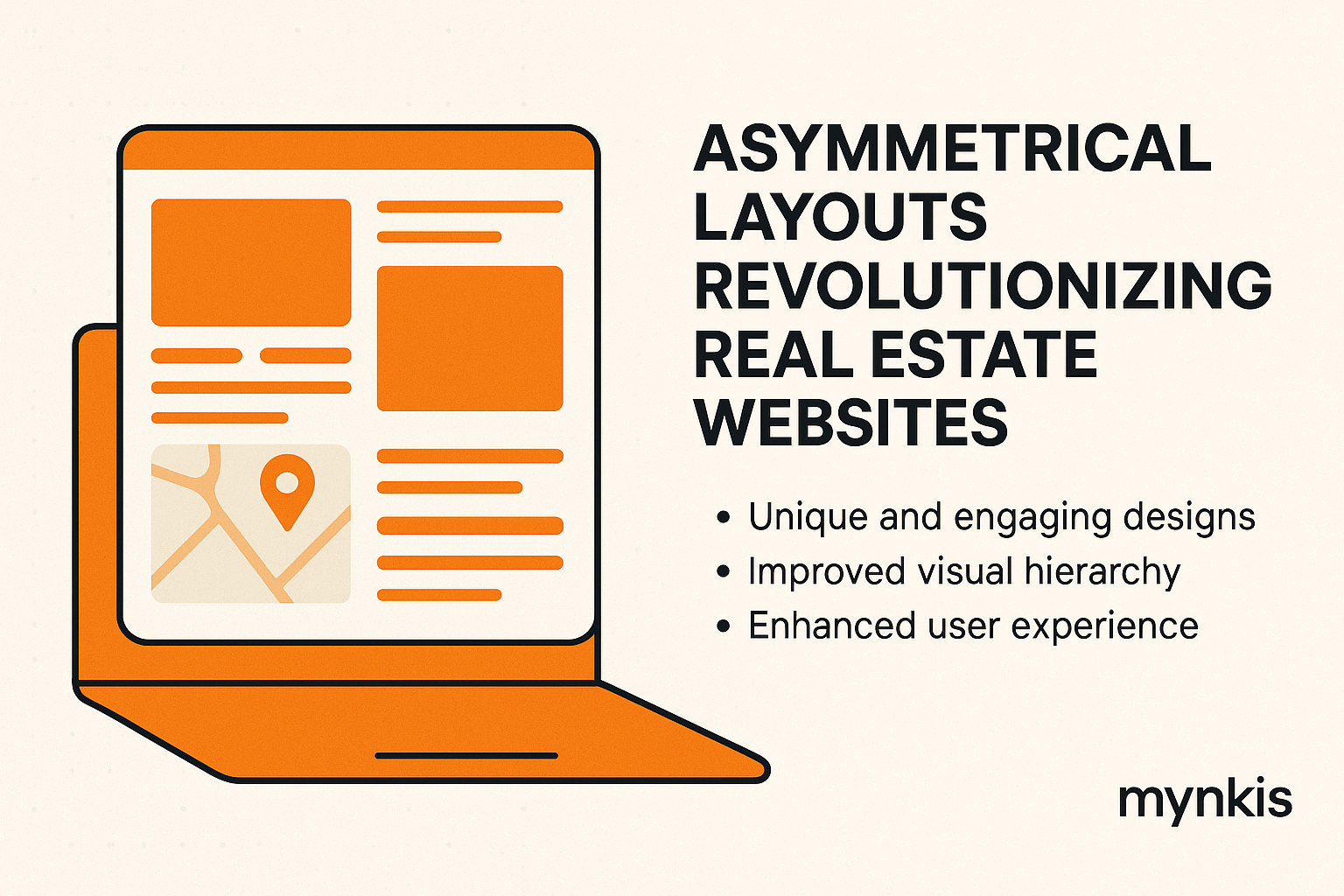Schedule a Demo
In my experience assisting with countless real estate projects, I've noticed that aesthetic trends often mirror broader design sensibilities. One particularly captivating approach I've observed gaining traction is the use of asymmetrical layouts in website design. This technique, which breaks away from the balanced grid system so prevalent in traditional design, offers a unique way to engage users on property listing websites.By utilizing asymmetrical designs, real estate brokers can enhance their site's visual appeal, drawing potential buyers into a more engaging and dynamic user experience.
It's essential to understand that asymmetry isn't just about aesthetics. It can also contribute to SEO, particularly for brokers targeting local queries on their property listing websites. By strategically placing key information and calls to action in an engaging, dynamic format, you're more likely to increase dwell time and engagement metrics — both of which are known to be SEO-friendly.Google’s SEO Starter Guide emphasizes the importance of user engagement in SEO performance, supporting the potential benefits of an asymmetrical layout.
In my work with various brands, I've learned that an asymmetrical layout facilitates a more memorable user experience. By departing from the monotonous symmetry of traditional layouts, property listing websites can feature unique placements of property images, detailed descriptions, and brokerage information, enhancing not just aesthetic appeal but also practical navigation.This dynamic approach can make browsing properties feel more like an exploration, increasing user satisfaction and time spent on your site.
Let's delve into real-world applications of asymmetrical design in real estate websites. There’s a notable example where a broker in San Francisco used an asymmetric layout to highlight trending neighborhoods, resulting in a notable 30% increase in user engagement, per a case study from National Association of Realtors. In contrast, symmetrical layouts often lacked the 'wow' factor this approach offered, highlighting how innovation in design directly translates to better performance.
Implementing an asymmetrical design requires a nuanced approach to balance innovation with user expectation.
It's worth acknowledging that embracing asymmetry might not appeal to all potential clients. Some users might find highly asymmetrical designs less user-friendly, particularly if accessibility or visual coherence is compromised.Therefore, finding the right balance is crucial. Your asymmetrical design should be thoughtful, ensuring it does not sacrifice usability for aesthetic appeal. While results vary based on individual design choices and user preferences, individual design testing might be needed to ascertain user response effectively.
There's a certain artistic flair in creating an asymmetrical layout. It's like painting with elements, space, and movement on the digital canvas of a property listing website. In my consultations with designers, I've emphasized balancing artistic creativity with functional design. The result? Properties are displayed in their best light, and clients get an engaging, visually coherent experience.Such an approach can make the journey of property browsing an aesthetically pleasing experience.
A key aspect to consider when adopting asymmetrical layouts is the technical dimension. Mobile responsiveness and load times are critical for real estate websites where images and detailed listings can tax site performance. Cutting-edge development techniques, including CSS Grid and Flexbox, offer remarkable tools for web developers to execute complex layouts while maintaining or improving site speed and accessibility, as suggested by resources like Web.dev.
When embarking on the journey of asymmetrical design for a property listing website, having the right tools is invaluable. Software solutions like Sketch and Figma provide robust environments where ideas can be tested and refined.For SEO features, platforms like Ahrefs can guide content placement to improve local search rankings. Here, balancing design creativity with technical SEO necessities creates a powerful synergy, making your site more attractive and discoverable.
Looking forward, the trend towards asymmetrical layouts in web design shows no signs of abating. I anticipate that future iterations will integrate more advanced animations and transitions to create even more immersive experiences on property listing sites.Evolving SEO practices that favor high-quality user experiences suggest that well-implemented asymmetrical designs will continue to gain ground in improving search visibility for local queries. Always keep an eye on how tech like AR and VR can further personalize the user experience within such dynamic layouts.
Integrating asymmetrical layout design into your real estate website can create a harmonious blend of form and function. As a tactic to bolster local query rankings, placing key content and features asymmetrically can lead to increased engagement and lower bounce rates — both appreciated by search engines like Google, per insights from Moz. It's like orchestrating a symphony where each element plays its part, enhancing the overall experience and effectiveness of the site.
When I guide clients through the process of redesigning their real estate website, I advocate for fostering creativity but within the bounds of usability.Your site's layout should surprise and delight, but it must also guide users smoothly to where they need to go. Achieving this balance in an asymmetrical design requires a keen sense of how design elements interact with user behavior patterns, gleaned from established user experience principles.
Customization offers a compelling advantage in asymmetrical layout designs for property listing websites. I've recommended clients tailor their layouts to highlight different properties or client segments, fostering a unique branding opportunity.By focusing on individual user journeys, your site can cater to various needs, from investors looking at high-level data to families focused on the neighborhood vibes.Forbes outlines the value of personalization, showing its role in boosting engagement and conversion rates.
The journey towards perfecting an asymmetrical layout is continuous. As an advocate for this design approach, I often emphasize that SEO and user experience (UX) data should be your guiding light. Through iterative design testing and analytics review, tailored especially for local market optimization, your website’s performance can evolve and excel.This journey isn't just about looking good; it's about providing a seamless, engaging experience that helps potential clients find the right property with ease and efficiency.
